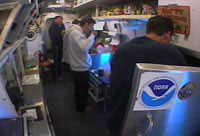Jim Leichter is a postdoctoral researcher at Woods Hole Oceanographic Institution. This is his fourth saturation diving mission at Aquarius, where a team of six aquanauts will spend nine days in the underwater laboratory 63 feet below the ocean’s surface in Florida Keys National Marine Sanctuary.
Monday, 12 Jun 2000
CONCH REEF, Fla
CONCH REEF, Fla. The whole crew was up early this morning, not exactly nervous, but certainly excited even though it was a short, short night of sleep after programming equipment, putting the final touches on a lot of gear, and packing the last of our dry gear in garbage bags — well into the wee hours. Anything such as computers and electronic equipment (and even clothes) that needed to come down to Aquarius dry had to be double- and triple-wrapped in ziplocks and garbage bags before it could be transferred in dry pressure chambers. You never know when a pressure chamber might leak. It’s a pretty unusual way to pack for a camping trip.

Little habitat in the ocean.
Photo: Tom Stack and associates.
The crew boat left the dock a bit after 7:00 this morning with our dry gear, but we waited another couple hours before heading out to the reef. The first dive of an Aquarius mission is the one that is probably the most different from any other dive. You start up at the surface on a boat on (in this case) a lovely, sunny summer day, you suit up in your scuba gear, you splash in off the boat and head down to the bottom, all like any dive … BUT, in this case, you know that you really aren’t planning a return to the surface anytime soon.
Added to that, the four of us in the science crew were carrying a collection of high-tech instruments probably worth considerably more than our total combined annual incomes. Okay, marine science isn’t known for its enormous salaries, but we did have two acoustic Doppler current meters, a Conductivity-Temperature-Depth-Fluorescence sensor, several recording Temperature probes, and, to add weight and in-water drag even if not a lot of monetary value, we each seemed to have a catch bag of sample bottles, data slates, and other associated bits of gear.

Taking a lunch break in Aquarius.
Photo: Aquarius webcam.
Well, we got all that equipment safely in place on the bottom during the morning dive, then came into Aquarius to have lunch, unpack, and get situated. Then we headed back out for an afternoon diving and sampling session. All in all, a very successful first day, leaving everyone happy to be here, but tired after about three and a half hours in the water and ready for sleep. Tomorrow, we’ll be up early to get started for about six hours of diving.

